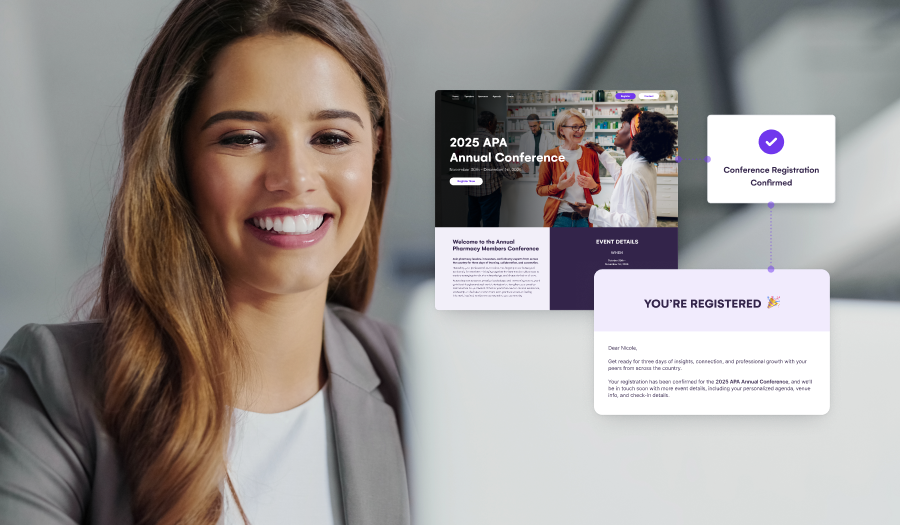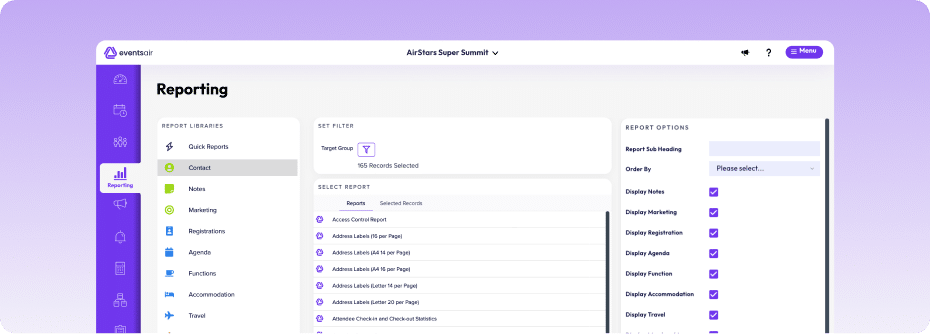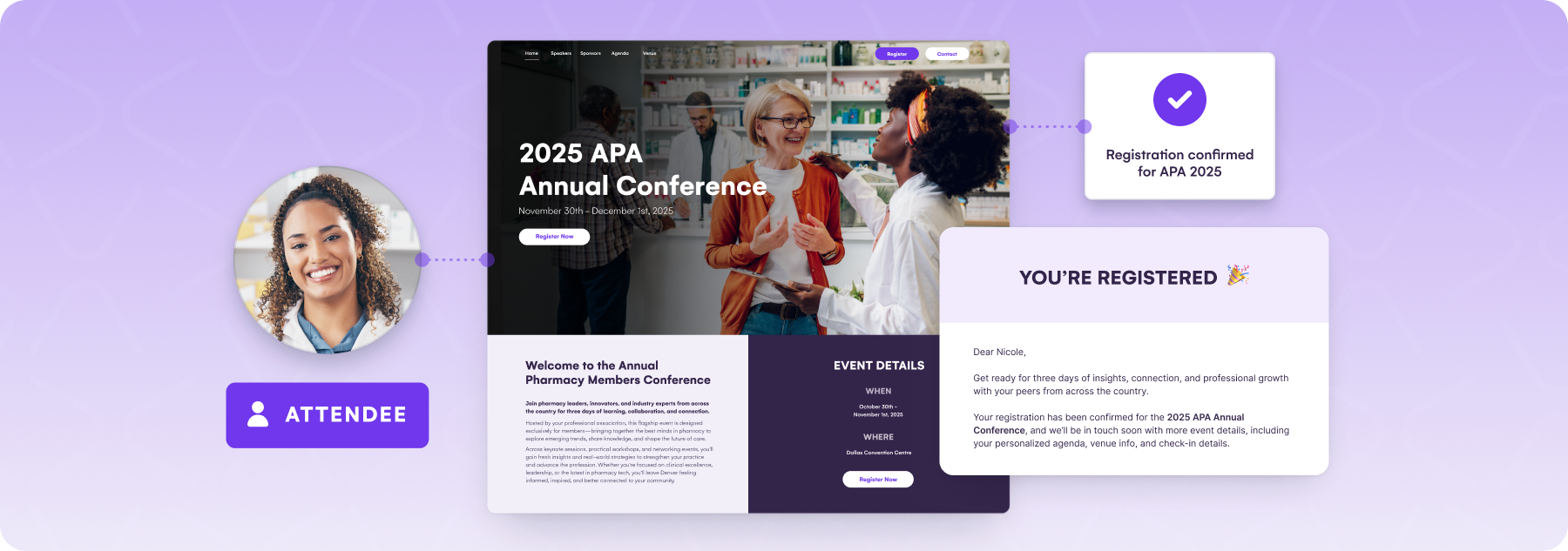
Professional Conference Organizers, associations, and corporate teams often face the same challenge: online registration processes that create more friction than flow.
In this step-by-step guide, we’ll show you how to create a smooth, stress-free online registration experience that works for attendees and organizers alike. From setting clear goals and designing intuitive forms to choosing the right platform, enabling tiered pricing, and optimizing for mobile, you’ll learn how to build a streamlined process from start to finish.
We’ll also highlight how tools like EventsAir can simplify and automate the experience, so you can focus less on admin and more on impact.
Why set up an online registration for an event?
Setting up online registration isn’t just about saving time; it’s about creating a better experience for both attendees and organizers.
Here’s why it matters:
- Streamlined attendee management: Online registration collects and organizes attendee information automatically, eliminating manual data entry and reducing errors. This makes it easier to track sign-ups and manage lists in real time.
- Better attendee experience: A clean, mobile-friendly registration page makes it quick and easy for people to sign up. Instant confirmation emails help reassure attendees that their spot is secured.
- Secure payment processing: Built-in payment gateways let you accept payments online safely and quickly. There’s no need to handle cash or chase down invoices, and your finances stay transparent.
- Real-time insights and analytics: Event organizers can monitor registrations as they happen, identify trends, and adjust marketing efforts to boost attendance before the event.
- Saves time and cuts costs: Online registration cuts down on manual work, paperwork, and staffing needs, freeing your team to focus on planning a great event. Tools like EventsAir offer intuitive workflows that make managing registrations simple and stress-free.

Setting up your online event registration: Step by step
1. Identify your goals and registration requirements
Before you dive into building your registration form, take a step back and get clear on what your event needs. The right setup starts with asking the right questions.
Start with the basics: What’s the purpose of your event?
Your registration process should reflect your event’s goals. Ask yourself:
- Are you aiming to drive leads, generate revenue, offer training credits, or grow your community?
- What does success look like: number of sign-ups, attendance rate, ticket revenue, or session participation?
Document these goals now. They’ll guide how your registration is structured and how you measure results later.
Clarify format, scale, and audience
Different event types call for different registration flows:
- Event format: Is your event in-person, virtual, or hybrid? Each one has its own data, communication, and check-in needs.
- Audience segments: Will you have different types of attendees, members, students, sponsors, or press? Define each group, their pricing (if any), and what information you need from them.
- Estimated attendance: Having a rough number helps you set capacity limits, manage tiers (like early bird or VIP), and plan waitlists.
Decide what information to collect
Keep your form short, clear, and purposeful:
- Essentials: Full name, email address, organization, and role.
- Optional or conditional fields: Dietary needs, accessibility requests, breakout session choices, or continuing education numbers.
- Sensitive data: Only ask for what’s truly needed, especially if it includes medical, billing, or ID information. Be ready to justify its use.
Map out your registration logic
This is where many events go wrong, so plan it early:
- Do you need single or group registration?
- Will you offer different ticket types, like free vs. paid, or early-bird vs. standard?
- Are approval workflows, promo codes, or invite-only sessions required?
List out every registration path upfront. It’s easier to build them in now than to fix gaps later.
Plan for compliance and consent
Make sure your registration process meets legal and ethical standards:
- Include GDPR checkboxes if you’re collecting EU data.
- Add terms for photo/video release, code of conduct, or export control disclaimers, if needed.
- Clearly display consent language where it matters—on the form, emails, or ticket confirmations.
2. Select the right registration platform
Your registration platform does more than collect names; it shapes the entire first impression of your event. A solid platform helps you streamline admin work, minimize errors, and deliver a smooth sign-up experience that boosts attendance.
What to look for in a registration tool
The best platforms don’t just offer forms; they offer flexibility. Prioritize tools that let you:
- Customize the registration flow: Build forms tailored to your event’s structure. Whether you need simple sign-ups or multi-tier ticketing with conditional fields, customization ensures relevance and ease for every registrant.
- Accept secure, flexible payments: Make it easy for attendees to pay how they prefer; credit card, digital wallet, or alternative local methods. Offering diverse options increases trust and reduces drop-offs, especially for global events.
- Recover abandoned registrations: The ability to track incomplete registrations (cart abandonment) is critical. Choose tools that allow you to easily report on these incomplete registrations or enable retargeting emails for those who start but don’t finish signing up.
- Track registrations in real time: Monitor sign-ups, payments, and ticket types with live dashboards. This visibility helps you pivot quickly, whether you’re scaling up marketing or adjusting capacity limits.
- Connect with your existing tools: Integrate registration with your CRM, email platform, and event app to eliminate duplicate entry and ensure consistent data across your event ecosystem.
EventsAir combines all of the above in one powerful all-in-one event management platform. With a drag-and-drop form builder, embedded payment processing (EventsAir Pay), abandoned registration tracking, and real-time analytics, it’s designed to remove friction from registration—while giving you full control behind the scenes.
3. Create and customize your registration page
Your registration page is often the first interaction attendees have with your event, so it needs to be clear, professional, and easy to use. A well-designed page not only boosts sign-ups but also builds confidence in your event from the first click.
To achieve this, aim for a registration page that is visually aligned with your event branding, provides clear information at a glance, and guides users intuitively through the sign-up process, whether they’re on desktop or mobile.
Focus on clarity and branding
Keep the layout simple and focused. Include key event details at the top: name, date, location (or virtual link), and ticket pricing. Avoid clutter and highlight what matters most.
Use your brand colors, logo, and visuals to make the page recognizable and trustworthy. A cohesive look improves the overall attendee experience.
Make it mobile-friendly
More than half of event registrations happen on mobile devices, so mobile responsiveness is a must. Your page should load fast, with buttons and forms that adapt to any screen size. A mobile-first design can significantly reduce drop-offs.
Streamline the form fields
Simplicity wins when it comes to forms.
Request only the data you truly need; think name, email, and ticket type. And, use dropdowns and checkboxes where possible to make the process faster and less intimidating for attendees.
With EventsAir, you can easily build forms using a drag-and-drop editor and even personalize the form based on attendee type (e.g., member, sponsor, student).
Enhance the attendee experience
Small touches can make a big difference.
- Add tooltips or brief FAQs next to form fields to reduce confusion.
- Use countdown timers or limited-seat alerts to drive urgency.
- Show progress bars or confirmation messages to guide the user step by step.
4. Automate payments and communication
Once your registration page is live, it’s time to take two critical steps: enabling smooth payments and setting up automated communications. These elements not only improve the attendee experience but also cut down on manual admin for your team.
Set up secure online payments
A reliable, frictionless payment process builds trust and minimizes registration drop-offs. That’s where EventsAir Pay comes in.
Unlike third-party gateways, EventsAir Pay is fully embedded within your registration workflow, no redirects, no external logins. It supports a wide range of payment options, including credit/debit cards, Apple Pay, Google Pay, and WeChat Pay, giving your attendees more ways to pay.

Enable automated confirmation emails
After registration, attendees expect instant confirmation. These emails act as both proof of payment and reassurance that their registration was successful.
Make sure your confirmation email includes:
- Event details like date, time, and venue (or virtual link).
- Payment summary or invoice.
- Next steps, such as downloading an event app or saving the event to their calendar.
Send reminders and updates
Timely reminders keep attendees engaged and reduce no-shows. You can use these emails to share important information like
- Final schedules or session changes
- Speaker highlights
- Travel and access info for in-person events
- Secure access links for virtual sessions
5. Test, launch, and monitor
Before going live, thorough testing and monitoring are essential to ensure a smooth registration experience. A single glitch can lead to lost sign-ups, frustrated attendees, or inaccurate data. This final step ties all your efforts together.
Test your registration process
Think like an attendee. Test the entire registration flow, from visiting the page, filling in the form, and making payments to receiving confirmation emails.
- Check form logic: If you have conditional fields (e.g., different questions for VIP tickets), make sure they display correctly.
- Simulate multiple devices: Test on desktops, tablets, and smartphones to confirm the page is mobile-friendly.
- Verify payment gateways: Complete a test transaction to ensure payments are processed correctly and securely.
- Check email automation: Confirm that automated emails (confirmation, reminders) are triggered at the right times.
Launch confidently
Once you’re satisfied with testing, it’s time to launch. Announce your registration page across marketing channels: social media, email campaigns, and your event website.
- Use clear CTAs like “Register Now” or “Save Your Seat” to drive action.
- For paid events, consider early-bird discounts to encourage early sign-ups.
- EventsAir’s built-in marketing tools can help you launch faster with automated email campaigns and landing pages.
Monitor registrations in real-time
Going live isn’t the end; active monitoring helps you spot issues and optimize performance.
- Track sign-up trends: Use dashboards or analytics tools like those to see which ticket types are selling fastest.
- Identify bottlenecks: If sign-ups stall, review your page’s performance, marketing efforts, or form complexity.
- Monitor communication: Ensure confirmation emails are being delivered to inboxes, not spam folders.
Optimize and improve
Use the insights you gather to make timely adjustments. For example, if mobile sign-ups lag, check mobile responsiveness. If a specific session isn’t filling up, send a targeted email highlighting its benefits.
Bonus strategies to get the most out of your online event registration setup
- Leverage early-bird and tiered pricing: Offering time-sensitive discounts encourages early sign-ups and helps forecast attendance. Tiered pricing (e.g., general admission vs. VIP) also adds flexibility for different attendee budgets.
See our guide on how to build an effective event pricing strategy that maximizes ROI. - Integrate social media sharing: Add share buttons or social prompts during or after registration. This simple step encourages attendees to promote your event organically, expanding your reach.
- Offer multi-language support: For global events, supporting multiple languages on the registration page improves inclusivity and drives higher sign-ups from international audiences.
- Track marketing attribution: Use UTM codes or tracking links on campaigns to identify which marketing channels drive the most registrations. This allows you to focus your budget on the most effective platforms.
- Enable group or team registration options: Allowing attendees to register multiple participants at once (e.g., coworkers, students, or teams) streamlines the process for organizations and boosts total sign-ups.
Streamline event registration from start to finish with EventsAir
A seamless registration process can set the tone for your entire event, boosting sign-ups, minimizing no-shows, and delivering a better experience for everyone involved. But getting all the moving parts right, from forms and payments to confirmations and compliance, takes more than guesswork.
That’s where EventsAir comes in. As an all-in-one event management platform, it empowers you to build custom registration flows, accept secure payments, automate communications, and monitor everything in real-time. Whether you’re planning a workshop or a global summit, EventsAir gives you the tools to streamline your registration process without the hassle.
Ready to simplify your next event? Book a demo with EventsAir today.
Event Planning & Management | Registration
See EventsAir in action
Discover why 12,000+ event professionals trust EventsAir to deliver effortless events, every time.




